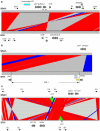Complete genome sequence of Shigella flexneri 5b and comparison with Shigella flexneri 2a
- PMID: 16822325
- PMCID: PMC1550401
- DOI: 10.1186/1471-2164-7-173
Complete genome sequence of Shigella flexneri 5b and comparison with Shigella flexneri 2a
Abstract
Background: Shigella bacteria cause dysentery, which remains a significant threat to public health. Shigella flexneri is the most common species in both developing and developed countries. Five Shigella genomes have been sequenced, revealing dynamic and diverse features. To investigate the intra-species diversity of S. flexneri genomes further, we have sequenced the complete genome of S. flexneri 5b strain 8401 (abbreviated Sf8401) and compared it with S. flexneri 2a (Sf301).
Results: The Sf8401 chromosome is 4.5-Mb in size, a little smaller than that of Sf301, mainly because the former lacks the SHI-1 pathogenicity island (PAI). Compared with Sf301, there are 6 inversions and one translocation in Sf8401, which are probably mediated by insertion sequences (IS). There are clear differences in the known PAIs between these two genomes. The bacteriophage SfV segment remaining in SHI-O of Sf8401 is clearly larger than the remnants of bacteriophage SfII in Sf301. SHI-1 is absent from Sf8401 but a specific related protein is found next to the pheV locus. SHI-2 is involved in one intra-replichore inversion near the origin of replication, which may change the expression of iut/iuc genes. Moreover, genes related to the glycine-betaine biosynthesis pathway are present only in Sf8401 among the known Shigella genomes.
Conclusion: Our data show that the two S. flexneri genomes are very similar, which suggests a high level of structural and functional conservation between the two serotypes. The differences reflect different selection pressures during evolution. The ancestor of S. flexneri probably acquired SHI-1 and SHI-2 before SHI-O was integrated and the serotypes diverged. SHI-1 was subsequently deleted from the S. flexneri 5b genome by recombination, but stabilized in the S. flexneri 2a genome. These events may have contributed to the differences in pathogenicity and epidemicity between the two serotypes of S. flexneri.
Figures


Similar articles
-
Identification of a putative pathogenicity island in Shigella flexneri using subtractive hybridisation of the S. flexneri and Escherichia coli genomes.FEMS Microbiol Lett. 2002 Aug 6;213(2):257-64. doi: 10.1111/j.1574-6968.2002.tb11315.x. FEMS Microbiol Lett. 2002. PMID: 12167547
-
Bacteriophages are the major drivers of Shigella flexneri serotype 1c genome plasticity: a complete genome analysis.BMC Genomics. 2017 Sep 12;18(1):722. doi: 10.1186/s12864-017-4109-4. BMC Genomics. 2017. PMID: 28899344 Free PMC article.
-
Deletion of pic results in decreased virulence for a clinical isolate of Shigella flexneri 2a from China.BMC Microbiol. 2013 Feb 8;13:31. doi: 10.1186/1471-2180-13-31. BMC Microbiol. 2013. PMID: 23391153 Free PMC article.
-
A chromosome map of Shigella flexneri with the loci related to pathogenicity.Mol Gen Mikrobiol Virusol. 1994 Jan-Feb;(1):3-10. Mol Gen Mikrobiol Virusol. 1994. PMID: 8133848 Review. No abstract available.
-
[Molecular genetic studies on virulence-associated chromosomal loci of Shigella flexneri 2 a].Nihon Saikingaku Zasshi. 1993 Nov;48(6):729-38. doi: 10.3412/jsb.48.729. Nihon Saikingaku Zasshi. 1993. PMID: 8309077 Review. Japanese. No abstract available.
Cited by
-
Organised genome dynamics in the Escherichia coli species results in highly diverse adaptive paths.PLoS Genet. 2009 Jan;5(1):e1000344. doi: 10.1371/journal.pgen.1000344. Epub 2009 Jan 23. PLoS Genet. 2009. PMID: 19165319 Free PMC article.
-
Chromosomal rearrangements in Salmonella enterica serovar Typhi strains isolated from asymptomatic human carriers.mBio. 2011 Jun 7;2(3):e00060-11. doi: 10.1128/mBio.00060-11. Print 2011. mBio. 2011. PMID: 21652779 Free PMC article.
-
Mechanism of Escherichia coli resistance to Pyrrhocoricin.Antimicrob Agents Chemother. 2014 May;58(5):2754-62. doi: 10.1128/AAC.02565-13. Epub 2014 Mar 3. Antimicrob Agents Chemother. 2014. PMID: 24590485 Free PMC article.
-
A novel glucosyltransferase involved in O-antigen modification of Shigella flexneri serotype 1c.J Bacteriol. 2009 Nov;191(21):6612-7. doi: 10.1128/JB.00628-09. Epub 2009 Aug 28. J Bacteriol. 2009. PMID: 19717593 Free PMC article.
-
Inferring genomic flux in bacteria.Genome Res. 2009 Feb;19(2):306-17. doi: 10.1101/gr.082263.108. Epub 2008 Nov 17. Genome Res. 2009. PMID: 19015321 Free PMC article.
References
-
- Mei Y, Liu H, Xu J. Cloning and application of genus specific DNA probes for Shigella. Chinese J Epidemiol. 1989;10:167–170.
Publication types
MeSH terms
Substances
LinkOut - more resources
Full Text Sources
Other Literature Sources
Molecular Biology Databases
Miscellaneous

